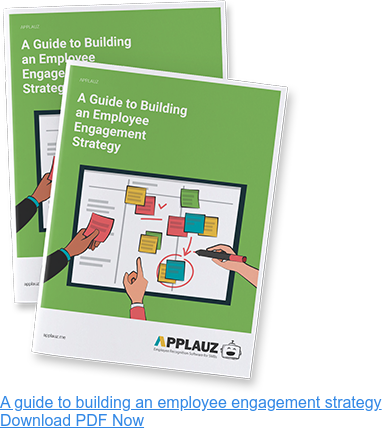“People often say that motivation doesn't last. Well, neither does bathing – that's why we recommend it daily,” famously said motivational speaker Zig Ziglar.
It turns out, motivation at work also requires sustained efforts. While personal motivation is, well, personal, employee motivation is every leader’s business. If you want to create a workplace filled with motivated people, here’s what you need to know.
 What Is Employee Motivation and Why Is It Crucial?
What Is Employee Motivation and Why Is It Crucial?
Most definitions of the term “motivation” involve the initiation and sustainment of goal-directed actions. Motivation is about the forces that drive behavior. Similarly, employee motivation refers to the internal and external forces that lead people to take action in pursuing their work-related goals.
Motivated employees are more productive and have a positive impact on the success of an organization. Which we can see in studies like the one found in the Academy of Management Journal where they noted a positive correlation between employee job satisfaction and organizational financial performance.
To reinforce the importance of keeping your employees motivated, Gallup data shows that actively disengaged employees cost the U.S. between $450 billion to $550 billion in lost productivity yearly, and “are more likely than engaged employees to steal from their companies, negatively influence their coworkers, miss workdays, and drive customers away.”
In other words, employee motivation is good for business. But it’s also good for people: Motivated employees are happier. They also help create a positive work environment.
 Different Types of Motivation and How to Leverage Them
Different Types of Motivation and How to Leverage Them
If you want to know how to improve the motivation of your employees, you should know about the two main types of motivation: Intrinsic and extrinsic motivation. The former refers to motivation that arises from within, and the latter describes motivation that comes from external factors.
Intrinsic motivators include things like feeling valued at work, feeling proud of yourself for completing a project, or finding purpose in your responsibilities. Extrinsic motivators include things like salary, bonuses and work conditions.
According to Harvard Business Review research, employees tend to be driven by four basic drives, which include both intrinsic and extrinsic factors:
- The need to acquire money, goods, and status.
- The need to bond and form connections.
- The need to comprehend – to satisfy curiosity, grow and learn.
- The need to defend – to protect against threats, and promote justice.
Wondering how to leverage this knowledge to increase employee motivation? Focus on two key factors: the behavior of those in leadership positions, and your systems and processes.
Gallup research further revealed that managers can influence as much as 70% of an employee’s motivation. It is therefore critical for managers to embody certain traits and behaviors to keep employees motivated. Wisely promoting and hiring people in leadership roles is key, but so is equipping leaders with the tools and training to manage people well.
Additionally, a study published in Frontiers in Public Health showed that a positive work environment has the power to improve employee performance while significantly boosting employees’ commitment levels and their achievement-striving ability. Implementing systems that build a positive culture is important – it’s not something you should leave up to chance.
To help you get started, here are 15 tips to motivate employees effectively.
 15 Tips to Motivate Employees
15 Tips to Motivate Employees
-
Share positive feedback
Did you know that nearly all employees do their best work when they feel valued? A survey conducted by the American Psychological Association (APA) revealed that 93% of the respondents who reported feeling valued said that they are motivated to do their best at work.
Sharing positive feedback is a surefire way to improve employee motivation. Feeling appreciated is a human need, after all. A platform like Applauz can help you bake appreciation into your culture through effective processes so that everyone gets positive feedback on a regular basis.
-
Prioritize Transparent Communication
Transparency is the name of the game when it comes to building trust between leaders and employees. When you prioritize honest, transparent communication, you strengthen that trust. As a result, employee motivation grows.
Regular communication also helps dispel uncertainty and confusion, which can cause anxiety and affect motivation levels negatively.
Additionally, it creates an environment where people feel more comfortable sharing opinions and ideas, which contributes to feelings of engagement and job satisfaction.
-
Offer Employees Flexibility
Flexibility is one of the most sought-after job perks. It also improves motivation by accommodating the diverse needs of employees and making them feel valued as people first – not just a business resource.
When workers are offered the autonomy to manage their own work schedules or work from home, they are able to maintain a better work-life balance and feel more satisfied at work. Not every workplace or role in a company can be fully remote or asynchronous, of course, and there are benefits to connecting in person with coworkers. That said, offering some level of flexibility is important if you want team members to be motivated.
-
Create a Collaborative Environment
Creating a collaborative environment through initiatives that foster creativity, teamwork and cross-departmental collaboration is also a great way to motivate employees. Not only is collaboration stimulating, but it also fosters a sense of camaraderie and shared purpose.
When you tap into collective strengths while providing a platform for various individual contributions to shine, magic can ensue, and morale is guaranteed to skyrocket.
-
Provide Career Development Opportunities
Some people would love to attain a prestigious position. Others would be incredibly motivated by the possibility of increasing their paycheck regardless of the job title. Most people would agree that learning, growing and being challenged is motivating. Even though the ideal path may vary from person to person, providing career development opportunities is essential to keeping employees motivated.
Reach out to your employees individually and work with them to plan out their career trajectory. If they feel you’re invested in their growth, then they are more likely to want to grow together.
-
Get to Know People Individually
On that note, when managers get to know people individually, they are able to understand them on a deeper level. This is helpful in terms of supporting employees to grow within the organization, but also to build deeper relationships. People are more motivated to give their best when they feel invested in their job, but they need to feel that the investment goes both ways.
Ask questions. Talk about things other than work during your one-on-one meetings. Take a genuine interest in your reports and you’ll be amazed at how much more engaged they become.
-
Recognize Employee Achievements
Yes, employee recognition is a powerful tool for motivating people. But not all recognition efforts are created equal. Research published in the Journal of Education and Practice revealed that “effective recognition occurs in organizations that have a strong supportive culture, understand the psychology of praising employees for their good work, and apply the principles of employee recognition.”
So, recognize people when they go above and beyond to deliver outstanding performance. But make sure that you foster a workplace culture where people value the act of appreciating each other and where positive feedback is a daily habit.
-
Set Clear and Attainable Goals
People can’t be motivated to reach a goal if they don’t fully grasp what they are aiming for. If you want to motivate your team, set clear and attainable goals. While you do want targets to feel like a stretch, they need to be realistic. Otherwise, people will lose motivation and give up.
You’ll know that your goal-setting process is effective when you notice team members referring to their objectives, tracking them and continuously optimizing strategies to achieve them.
-
Give Employees Decision-Making Power
Nothing kills motivation faster than micromanagement. When employees feel like they have the authority to make decisions at work, they automatically feel more connected to their responsibilities and the overall success of the company.
Empowering your people to make decisions also shows that you recognize their expertise, and that you trust your staff. This is great news for employee motivation.
-
Offer Competitive Compensation and Perks
Research shows that while people are motivated by money at work, it’s not the be-all-end-all. It’s important not to neglect compensation and perks, but they don’t need to always come in the form of money.
People have bills to pay, dental appointments to book, and may appreciate workplace perks like generous PTO or even fun team outings and free food. If you want to keep your staff motivated, do your best to offer competitive compensation and benefits in conjunction with other employee appreciation and recognition efforts.
Keep in mind that you can tie perks to recognition efforts, too. For example, Applauz allows you to build a tailored rewards catalog that employees can redeem as they earn rewards by being recognized.
-
Get Input From Your Team
Getting input from your team is another way to motivate employees. First, it shows that you value their insights and opinions. It also ensures that people feel a sense of ownership over their work, which is motivating.
Not to mention the fact that encouraging diverse perspectives around the table contributes to innovation and creative problem-solving – and being part of a winning team sure fuels motivation. Consider tools like pulse surveys to continuously gather valuable employee feedback.
-
Take DEI Seriously
As mentioned above, diversity creates strong cultures. Putting Diversity, Equity, and Inclusion (DEI) at the forefront of your culture-building efforts is also important for employee motivation. When employees perceive that they work in a fair workplace, they feel greater trust in their organization and believe their efforts will be rewarded fairly. As a result, they are more likely to be motivated.
When done well, DEI initiatives should also provide equal opportunities for career advancement – a powerful motivator for women, BIPOC employees, and other marginalized groups who are used to being considered secondary or not taken into consideration at all.
-
Encourage Respectful Relationships
Respect in the workplace matters. Being disrespected, harassed or bullied in any way can drive the most motivated employee out the door.
As a leader, make it your mission to encourage respectful relationships within your team and in all your interactions. Here are a few things you can do: model behaviors like active listening, refuse to engage in office gossip, and lead by example with inclusive terminology. When coworkers treat each other with consideration, it forms the foundation for a supportive workplace culture and motivates people across the board. Lead with empathy.
-
Cultivate Psychological Safety
According to Harvard Business Review, psychological safety in a team is “a shared belief held by members of a team that it’s OK to take risks, to express their ideas and concerns, to speak up with questions, and to admit mistakes — all without fear of negative consequences.”
Psychological safety is paramount to employee motivation. Does the concept feel a little abstract when you try to figure out where your team stands? Amy Edmondson, the Harvard Business School professor and author of “The Fearless Organization” who coined the term, has developed a questionnaire to help identify whether a team has a high level of psychological safety, which she shared with HBR readers:
- If you make a mistake on this team, it is not held against you.
- Members of this team are able to bring up problems and tough issues.
- People on this team sometimes accept others for being different.
- It is safe to take a risk on this team.
- It isn’t difficult to ask other members of this team for help.
- No one on this team would deliberately act in a way that undermines my efforts.
- Working with members of this team, my unique skills and talents are valued and utilized.
-
Foster a Sense of Purpose and Meaning in Work
All the tips above ultimately help you create a workplace where different people can find a sense of purpose and meaning in their work. When work is tied to a larger purpose, intrinsic motivation gets fired up. Professionals driven by purpose experience increased engagement and job satisfaction, and they are also more resilient.
So, make sure you keep fostering that sense of purpose and meaning on a regular basis. Align your words with your actions – and, most importantly, with your core organizational values. Make sure that tasks and responsibilities are tied to high-level organizational goals, too. Finally, keep emphasizing impact in your communications.
Keep in mind that once a worker disengages, it takes more time and effort to bring their motivation back up. Genuine and consistent efforts to help people feel purposeful at work can go a long way to prevent disengagement.
 Can You Motivate Underperforming Employees?
Can You Motivate Underperforming Employees?
You may also be wondering whether the tips above can help you motivate underperforming employees who don’t seem to be responding to your efforts. The short answer is, yes, but you’ll need to personalize your approach.
If a team member has reached a point of active disengagement, they’ll require more personalized attention. As their manager, the first thing you’ll want to do is get curious about the situation and seek to understand what’s going on. Be patient as you build trust. Once you have real conversations about the person’s challenges, you can provide both constructive feedback and support.
Create a game plan, celebrate improvements, and check in on a regular basis. The idea is to inspire a commitment to improvement through continuous communication and empathy.
Motivating employees is not something you do once and for all. It’s a constant dance that involves high-level organizational efforts combined with excellent leadership. It’s worth it from a business standpoint. Above all, it’s rewarding to be the kind of leader who brings out the best in people.
About the author
Anouare Abdou
Anouare Abdou is a seasoned HR and business writer passionate about leadership, productivity, and the future of work. Her words have appeared in Business Insider, The Ladders, Thrive Global and more.



